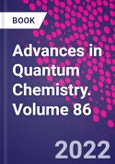Advances in Quantum Chemistry, Volume 86 highlights new advances in the field, with this new volume presenting topics covering Can orbital basis sets compete with explicitly correlated ones for few-electron systems?, Converging high-level equation-of-motion coupled-cluster energetics with the help of Monte Carlo and selected configuration interaction, Coupled cluster downfolding techniques: a review of existing applications in classical and quantum computing for chemical systems, Multi-reference methods for the description of dynamic and nondynamic electron correlation effects in atoms and molecules, Exploring the attosecond laser-driven electron dynamics in the hydrogen molecule with different TD-CI approaches, and much more.
Additional sections cover Molecular systems in spatial confinement: variation of linear and nonlinear electrical response of molecules in the bond dissociation processes, Relativistic Infinite-order two-component methods for heavy elements, Second quantized approach to exchange energy revised - beyond the S^2 approximation, Calculating atomic states without the Born-Oppenheimer approximation,� Convergence of the Correlated Optimized Effective Potential Method, and more.
Please Note: This is an On Demand product, delivery may take up to 11 working days after payment has been received.
Table of Contents
1. Can orbital basis sets compete with explicitly correlated ones for few-electron systems?Krzysztof Szalewicz
2. Converging high-level equation-of-motion coupled-cluster energetics with the help of Monte Carlo and selected configuration interaction
Piotr Piecuch
3. Coupled cluster downfolding techniques: a review of existing applications in classical and quantum computing for chemical systems
Karol Kowalski
4. Multi-reference methods for the description of dynamic and nondynamic electron correlation effects in atoms and molecules
Leszek Meissner
5. Exploring the attosecond laser-driven electron dynamics in the hydrogen molecule with different TD-CI approaches
Aleksander Wozniak
6. Molecular systems in spatial confinement: variation of linear and nonlinear electrical response of molecules in the bond dissociation processes
Wojciech Bartkowiak
7. Relativistic Infinite-order two-component methods for heavy elements
Maria Barysz
8. Second quantized approach to exchange energy revised
beyond the S^2 approximation
Piotr Zuchowski
9. Calculating atomic states without the Born-Oppenheimer approximation
Monika Stanke
10. Convergence of the Correlated Optimized Effective Potential Method
Szymon Filip Smiga
11. Generalized Relaxed Excitation with a Non-integer Particle and Hole Charge as an Excitation Order
Katarzyna Pernal
12. Vanadium
based Materials for Catalytic Applications: Insight from Density Functional Theory
Malgorzta Witko
13. Electronic convection in coherent information-theoretic description of molecular states
Roman F. Nalewajski
14. Interparticle correlations and chemical bonding from physical side: Exact diagonalization combined with ab initio wave function adjustment
Jozef Spalek and Ewa Broclawik
15. ETS-NOCV and Molecular Electrostatic Potential-based Picture of Chemical Bonding
Artur Michalak
16. Electrostatic Embedding for Elongation Cutoff Technique
Method Accuracy
Jacek Korchowiec
17. From the Kolos-Wolniewicz calculations to the quantum-electrodynamic treatment of the hydrogen molecule: competition between theory and experiment
Jacek Komasa
18. Making symmetry-adapted perturbation theory more accurate
Konrad Patkowski and Tatiana Korona
19. Advanced models of coupled cluster theory for the ground, excited and ionized states
Monika Musial and Stanislaw Kucharski








